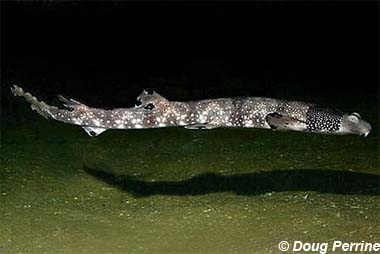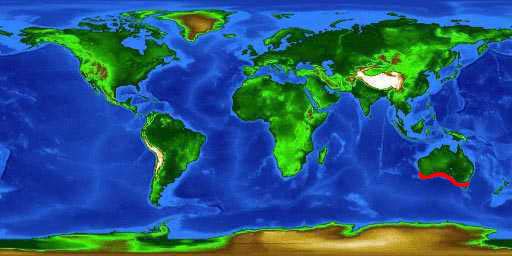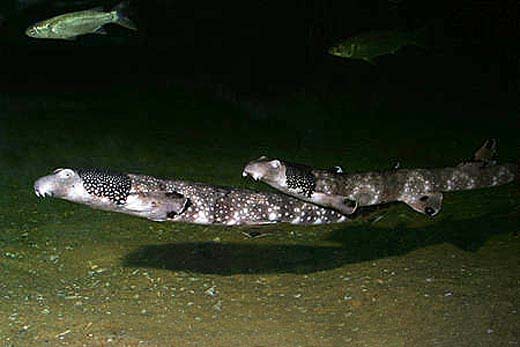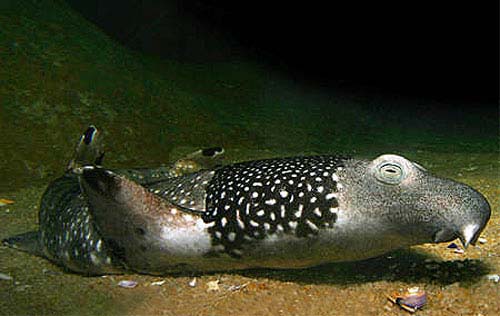Necklace Carpetshark

Parascyllium variolatum
These long, tubular sharks have small fins and asymmetrical tail fins, and short, rounded snouts. They are anywhere from dark to light brown with white spots, dark and light blotches, and dark saddles, but they all have a dark collar with dense white spots–hence the necklace name. They are shy, nocturnal sharks that forage in a wide variety of habitats and depths from seagrass beds to inshore sandy regions.
Order: Orectolobiformes
Family: Parascylliidae
Genus: Parascyllium
Species: variolatum
Common Names
English language common names referring to this species are necklace carpetshark, ring-necked catshark, southern catshark, varied carpet shark, varied carpetshark, and varied catshark. Other common names include alfombrera colarina (Spanish), halskettingtapijthaai (Dutch), pärlhalsbandshaj (Swedish), and requin carpette à collier (French).
Importance to Humans
This species is of no interest to commercial or recreational fisheries due to its size and depth range. It is also unlikely to be heavily impacted as a bycatch species in regional trawl and gillnet fisheries. Although it would make a great candidate for public aquarium facilities, its role in the aquarium trade is undocumented.
Danger to Humans
Due to its small size and feeding habits, the necklace carpetshark is considered harmless to humans.
Conservation
The necklace carpetshark is currently assessed as “Least Concern” by the World Conservation Union (IUCN) since due to its life history and ecology, it is unlikely to be impacted in commercial fisheries as bycatch. The IUCN is a global union of states, governmental agencies, and non-governmental organizations in a partnership that assesses the conservation status of species.
> Check the status of the necklace carpetshark at the IUCN website.
Geographical Distribution

The necklace carpetshark is endemic to the waters off southern Australia. It lives in the temperate inshore waters from eastern Victoria, Tasmania, and around the south of the country to southwestern Western Australia.
Habitat
This small shark occurs in a wide variety of habitats including over sandy bottoms, rocky reefs, kelp beds, and seagrass beds. It resides along the continental shelf at depths ranging from inshore down to approximately 590 feet (180 m). This species is nocturnal and rarely observed during daylight hours. Juveniles hide under rocks and debris in shallow waters.
Biology

Distinctive Features
The necklace carpetshark is an elongate, tubular-shaped shark with a short, broadly rounded snout. The head is narrow with small oval eyes and a small inferior mouth. The eyes are located entirely posterior to the mouth. Barbels are absent on the throat. The two spineless dorsal fins are similar in size with the origin of the first dorsal fin located behind the free rear ends of the pelvic fins. The origin of the anal fin is well ahead of the second dorsal fin origin. The pectoral fins are thick rounded, and muscular. The caudal fin is horizontally elongated and weakly heterocercal with its upper lobe barely elevated above the body axis. It has a strong terminal lobe and subterminal notch, as well as an undeveloped ventral lobe. The dorsal caudal-fin margin is less than one fourth the length of the entire shark.
A similar species may exist off southern Western Australia that also possesses white spots. However, if so, it is currently an undescribed species with specimens needed to be collected before a determination can be made.
Coloration
Ranging from light to dark brown with white spots, this shark is easy to identify. There is a broad black collar with dense white spot like a necklace of pearls in close proximity to the gills. The fins are blackish-brown with irregular black blotches. The margins of the fins are brown with white blotches. This coloration may vary considerably with individuals taking on varied coloration depending upon the bottom substrate including light spots and darker mottling as well as saddles.
Dentition
Within the family Parascyllidae, the teeth are not strongly differentiated in the upper and lower jaws. The symphysial teeth are not enlarged or fang-like. Each jaw possesses a tooth row count of 37-54/33-49 in adult specimens. The teeth have a strong medial cusp, a pair of short lateral cusplets, and strong labial root lobes. They are orthodont with a central pulp cavity and lacking osteodentine.

Size, Age, and Growth
The maximum reported size of the necklace carpetshark is 36 inches (91 cm) total length. The average size of adults ranges from 24- 36 inches (60-91 cm) total length.
Food Habits
Although little is known about the ecology and life history of the necklace carpetshark, it is presumed that it most likely feeds on invertebrates.
Reproduction
The necklace carpetshark is an oviparous species, releasing egg capsules into the marine environment. Each egg capsule is bulbous with two elongated horns; a third rudimentary horn may also be present. Scientific observations have noted oviposition rates varying from 12-39 days with one or two eggs deposited each time. Very little is known about the details of reproduction within this small shark.
Predators
Potential predators on juvenile and adult necklace carpetsharks include larger fish such as sharks as well as marine mammals. Snails, known predators of the eggcases of other species, may also feed on the eggcases of this species.
Parasites
There is a lack of scientific literature regarding the parasites of the necklace carpetshark.
Taxonomy
The necklace carpetshark was described as Hemiscyllium variolatum by Duméril in 1853. This name was later changed to the currently valid scientific name of Parascyllium variolatum (Duméril 1853). Synonyms includeParascyllium nuchalis McCoy 1874. The genus name, Parascyllium, is derived from the Greek “para” defined as the side of and “skylla” meaning a shark.
Prepared by: Cathleen Bester